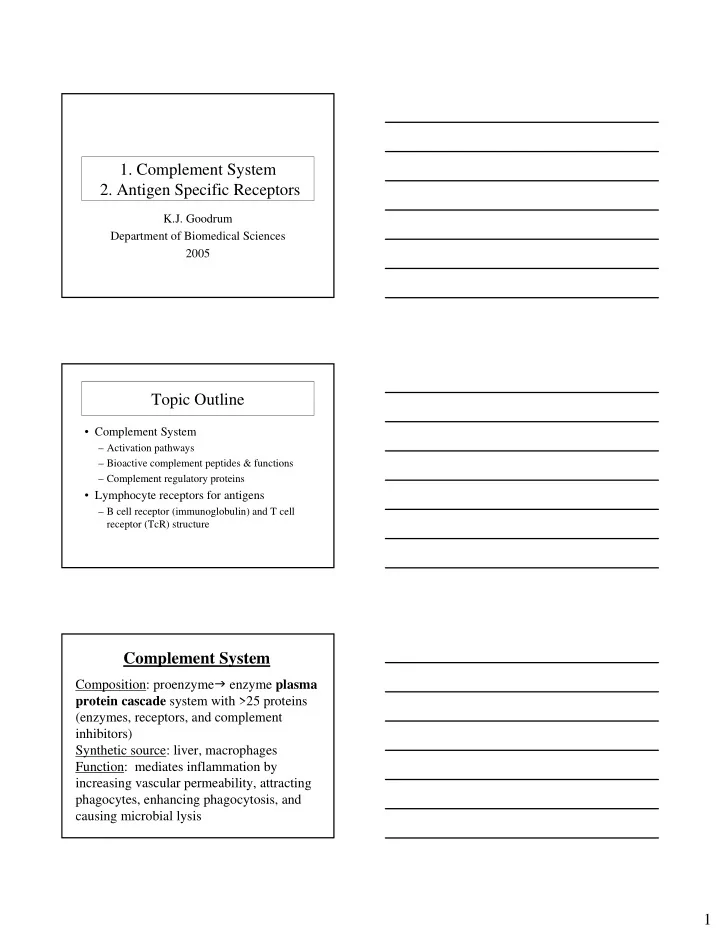

1. Complement System 2. Antigen Specific Receptors K.J. Goodrum Department of Biomedical Sciences 2005 Topic Outline • Complement System – Activation pathways – Bioactive complement peptides & functions – Complement regulatory proteins • Lymphocyte receptors for antigens – B cell receptor (immunoglobulin) and T cell receptor (TcR) structure Complement System Composition: proenzyme � enzyme plasma protein cascade system with >25 proteins (enzymes, receptors, and complement inhibitors) Synthetic source: liver, macrophages Function: mediates inflammation by increasing vascular permeability, attracting phagocytes, enhancing phagocytosis, and causing microbial lysis 1
Complement Activation Pathways, their activating signals, and common immune functions Classical Pathway Lectin Pathway Alternative Pathway Ag:Ab complex MBL:microorganism C3 H 2 O complex C1q MASP1 C3H 2 O C1r MASP2 B C1s Ba D MBL-MASP1-MASP2 C1 C3(H 2 O)Bb C4 C4a C4 C4a C3 C3a C14b MC4b Target bound C3b C2 C2a C2 C2a B C14b2b Ba MC4b2b D C3bBb C3 P C3bBbP C3a + C3b Terminal complement C3 convertases C3 pathway common to C14b2b all activation MC4b2b C3a pathways C3bBbP C14b2b3b or MC4b2b3b or (C3b)nBbP C5 convertases C5 C5a C5b C6 +C7 C5b67 C8 +C9 C5b678(9)n Membrane attack complex 2
Bioactive Complement Peptides • Plasma protease cascade generates peptides active in inflammation and innate immunity – C3a & C5a anaphylatoxins release histamine from mast cells � � vascular permeability – C5a chemotaxin , recruits phagocytes – C3b & C3bi opsonins (coats microbes to enhance recognition & uptake by phagocytes) – C5b6789n membrane attack complex (lyses microbial cell membranes) Classical Complement Pathway Classical Complement Pathway- continued 3
Alternative Complement Pathway -1 Alternative Complement Pathway -2 Alternative Complement Pathway -3 4
Classical and Alternate Pathway formation of C5 convertase and cleavage of C5 Terminal Complement Pathway and formation of the Membrane Attack Complex Cells detect and respond to complement peptides via cell-membrane receptors for complement peptides. 5
Spontaneous or chronic activation of complement is prevented by inhibitory proteins, both soluble and membrane associated. Antigen Recognition • B cells recognize antigens via membrane associated immunoglobulin molecules (antibodies) – Antigen-activated B cells synthesize and secrete a soluble form of this receptor (plasma antibody) which accumulates in fluids and specifically binds and eliminates the stimulating antigen. • T cells recognize antigens via a membrane associated heterodimeric protein, the T cell receptor or TcR – TcR are not secreted Antibody Activity • Antibodies specifically recognize and bind to the inducing antigen • Humoral immunity: antibody-mediated immunity can be transferred from an immune to a non-immune person by transfer of serum • The gamma-globulin protein fraction of serum contains the antibody activity 6
Basic antibody structure = 4 covalently attached polypeptide chains with 2 identical heavy (H) and 2 identical light chains (L) Each H and L chain have structurally constant (C) and structurally variable (V) domains. The Fab fragment of antibody molecules contains the antigen binding region. The Fc fragment determines antibody class and effector functions (complement interaction, opsonic activity) 7
The “immunoglobulin fold” refers to the characteristic 3D structure of V and C region domains. Hypervariable amino acid residues in the H and L chain V regions physically bind the antigen and determine the specificity of the antigen receptor. Hypervariable amino acid residues are located at the exposed ends of V domain loops. 8
V H and V L domains fold to form antigen binding sites that resemble pockets, grooves, open faces, or extrusions. The TcR binding site for antigen (one site per receptor) is also formed by the variable domains of an alpha and beta chain polypeptide. The structure of the T cell receptor (TcR) resembles that of antibody but consists of only 2 polypeptide chains with a single binding site. Each chain has a constant and variable structural domain. An αβ TcR and a γδ Tcr have been described. 9
Antigen interaction with receptors is noncovalent and reversible. There are 5 immunoglobulin classes based on structural similarity of the H chain C domains. IgM and IgA are secreted as pentamers and dimers respectively. The J chain protein promotes polymerization. 10
Nomenclature for structural differences between any 2 antibodies. Antigen-Antibody Reactions, Definitions and Characteristics to Know • Size of Epitope/antigenic determinant • specific,noncovalent,reversible binding • affinity vs. avidity • valency, crosslinking, agglutination,precipitation • multideterminant antigens, • heterogeneous antibody responses • cross reactions Soluble antigens mixed with equivalent amounts of soluble specific antibody can bind to form lattices (antigen-antibody complexes) large enough to become insoluble and precipitate. Insoluble (particulate) antigens + antibody form clumps (agglutinate). Fig A.9 11
Protective functions of antibody reactions with antigens. Protective functions of antibody interactions with antigen. -continued. Protective functions of antibody interactions with antigen. -continued. 12
Recommend
More recommend